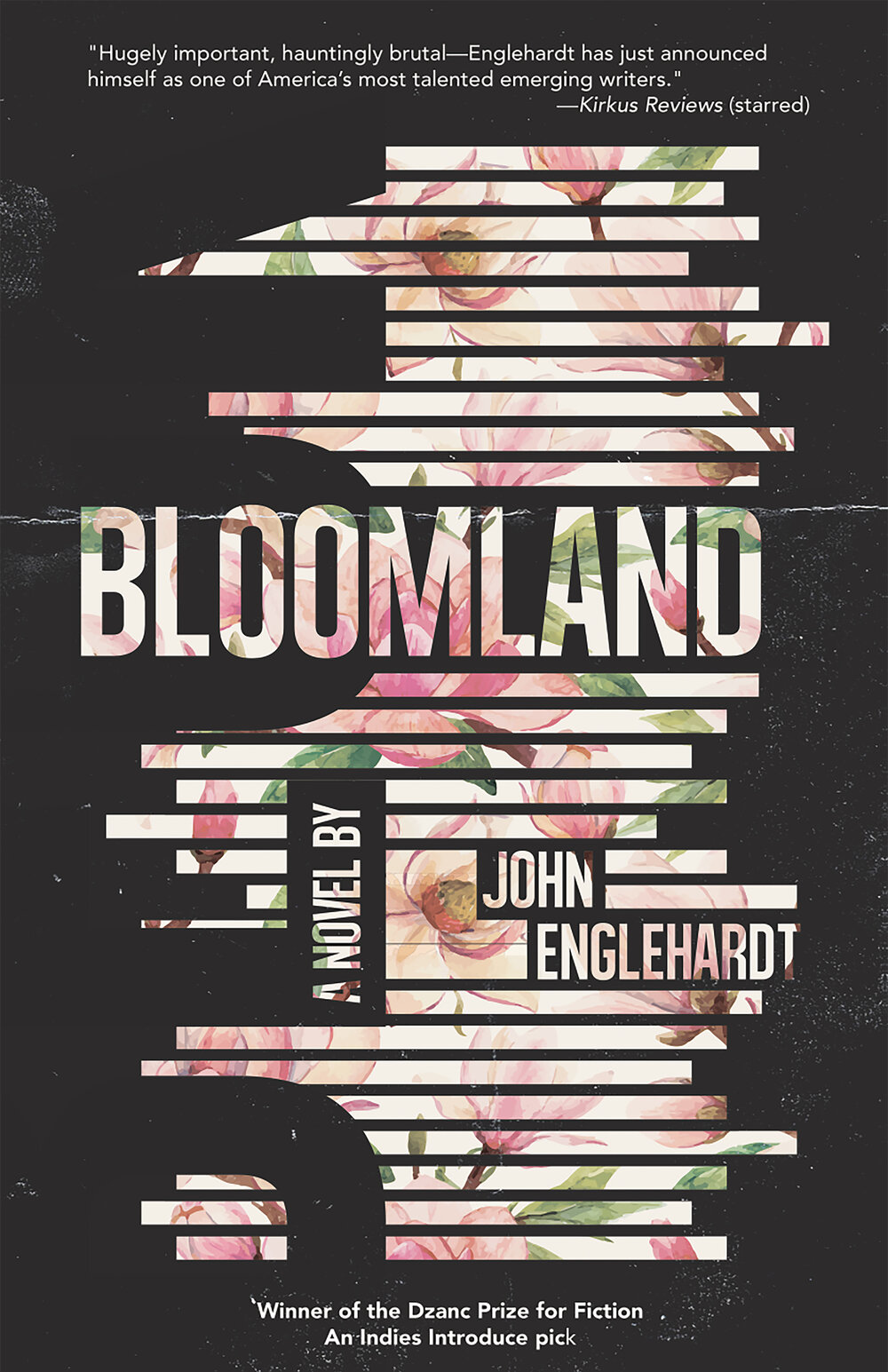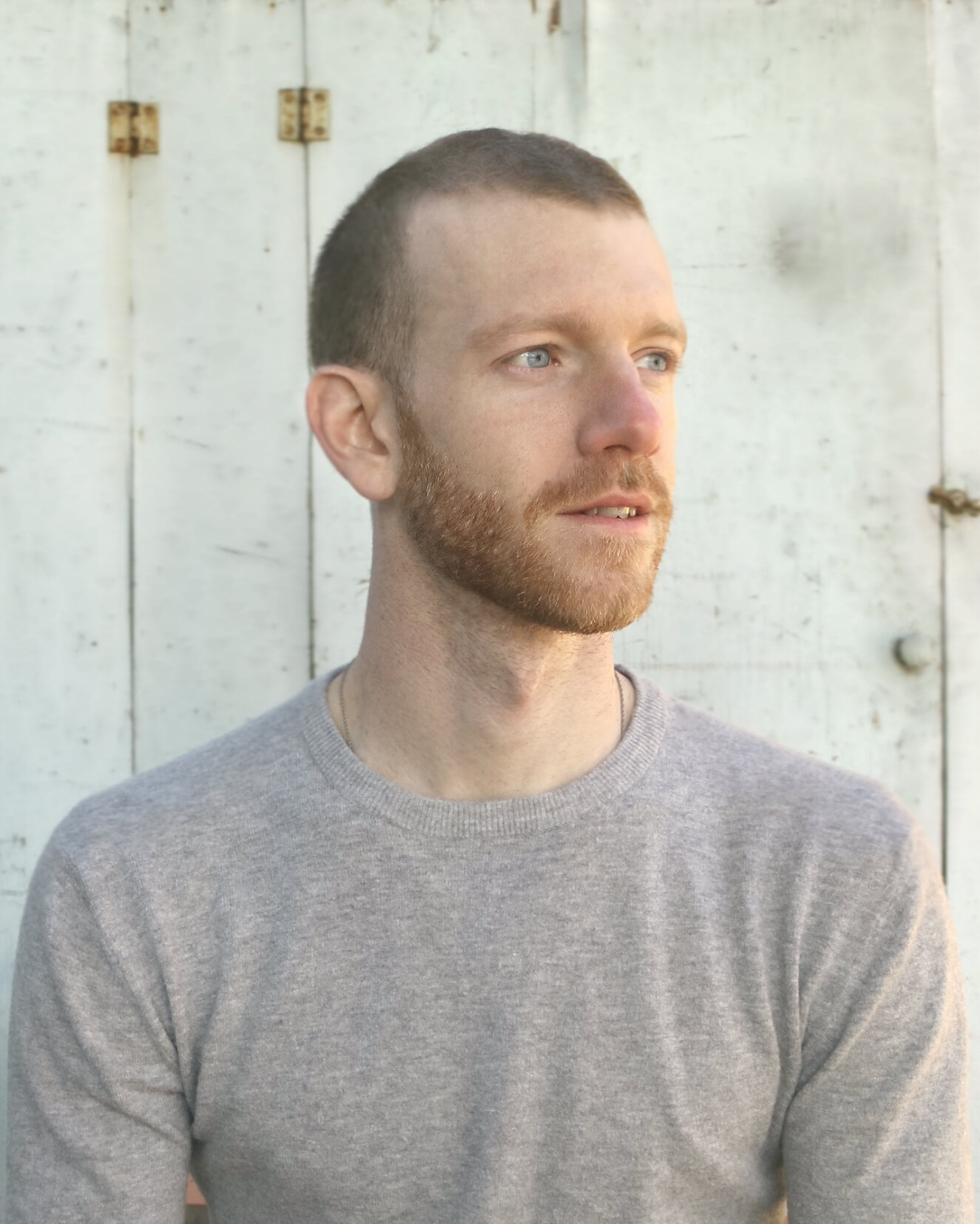
“A PLACE THAT DRAWS YOU IN”: An Interview About the Impact of Fayetteville, Trauma, and Transformation with Boomland Auther John Englehardt
By Samantha Sigmon
John Englehardt’s first novel Bloomland, released in September 2019, centers around the perspectives of three loosely-connected people struggling to reinvent themselves and find contentment at a southern university as they deal with their own trauma, psychological isolation, and dissatisfaction. Bloomland asks its readers what parts of us we take with us—voluntarily or not—when we move and change, and how we cope and grow after tragedy.
John received his MFA in 2014 from the University of Arkansas. While he lived in Fayetteville, he became very involved in the arts community. This region also greatly impacted his novel, which takes place at the fictional Ozarka University in Northwest Arkansas. I was able to ask John, now residing in Seattle, several questions about the importance of place, writing about trauma and violence, and the creative processes of structuring a novel.
Parlor: How did the premise of centering characters in Arkansas around a school shooting initially come about?
John Englehardt: When I started writing Bloomland in 2014, I was reflecting on the four years I spent at University of Arkansas. Initially, I wanted to explore the two different sides of higher education I’d experienced. On one hand, the writing program was an incredibly positive place of transformation and learning. But on the other hand, teaching undergrads for four years gave me glimpses into how college can be very corporatized—how it can lock students into their respective socioeconomic classes and give young men an alarming amount of social control. So, when I started what became Bloomland, I was not writing about a mass shooting. I had character sketches of students learning about art, entering the Greek system, and down-and-out adjuncts.
Then, in the summer of 2014, I moved from Arkansas back to Seattle (where I grew up) and there were a number of school shootings in the Pacific Northwest: Umpqua Community College, Marysville Pilchuck High School, and Seattle Pacific University. During that time, I read the news with a heightened awareness, and it occurred to me that the themes I was working with—like male entitlement or perceived disenfranchisement versus actual disenfranchisement—were directly related to the context of mass shootings. That’s when the premise for Bloomland came to me. For the next three years, I wrote these disjointed chapters that were basically snapshots of the lives of various characters involved. I filled them in, pushed them together, and by 2017 I had a complete draft, after which I spent about two years revising.
Parlor: What led to your decision to set your novel in the Ozarks, and how important is place to you with regards to writing this book? Any important times you had in Fayetteville that really changed how you think of Northwest Arkansas?
JE: Arkansas is one of the most beautiful, vivid, unsettling, unique, and misunderstood places I’ve ever been. When I packed up and moved there alone, so many ideas I had of the South were challenged or filled in. As a writer, that’s what I look for in a setting: a place that draws you in, and one that, when observed closely, challenges its myths.
Setting this novel in a place I was drawn to and connected to on a deep level was imperative because writing a book about a mass shooting meant I had be able to imagine how a community would manage the fallout of such an event. A fictional town in Arkansas was one of the only places I could have set this book.
Bloomland Press Cover (1).jpg
Speaking to my time in Fayetteville, though, a reviewer once called Bloomland a “kaleidoscopic wreck,” and honestly can’t think of a better way to describe the four years I spent there. I got my heart broke, fell in love, grew as a writer, taught, played music, made friends, and felt very alone. Amidst all that, one of the best experiences I had was working at a restaurant (the now-closed Greenhouse Grille in Fayetteville) the first summer I was there. Not only did I work with an amazing array of people, but people that probably could see how new and alone I was. They invited me to shows, drove me to swimming holes, introduced me to other artists, and taught me how to square dance. It made me feel part of a community—not just someone attached to the university.
Parlor: How did you settle upon creating three narratives around a school shooting and can you explain further about parallels amongst the multi-person perspectives?
JE: One of the central questions of the book is how a community could create, enable, and overlook someone as disconnected and angry as Eli, the shooter. To answer this, I felt it was necessary to look at characters who were not only centrally affected by the shooting, but also tangentially related. I needed their various life experiences to refract off of each other. For example, early on in the book, Rose and Eli arrive at college hoping to outrun their traumatic pasts. They’re trying to fit in, to leapfrog socioeconomic class, and to become new people. For them, that’s the promise of higher education. But when that hope is shattered, they take two very different paths. Rose reaches out to other people and begins to look elsewhere for fulfillment and meaning. Eli stops in his tracks and clings to the idea that the community promised him something and should face consequences for not delivering that thing to which he feels entitled. Later on in the book, the way Eddie deals with the loss of his wife appears very similar to the way Eli dealt with the loss of his mother—the way he turns inward and intellectualizes the problem. It’s those kind of moments I was hoping for when using this multi-perspective device.
Parlor: The beginning of each chapter consists of the name of one of the three characters and a title as well. How do the titles relate to the structure and themes of the novel? Where did the idea of “Bloomland” come about for both a title and recurring idea of hope as these people try to flourish in the world of academia?
JE: When I started Bloomland, the only way that I could stomach the daunting task of writing a novel was to convince myself I was just writing short stories. That’s why each chapter has this self-contained structure, down to the titles. Thematically, though, I really liked the idea of having chapter titles repeat some sentiment or piece of advice that a character takes to heart, despite its faulty logic. Chapters like “No Fear” (which references the slogan Eli stencils onto his fishing boat) or “Be Okay, It Will Be Okay” (the cheer of the hostile sorority Rose joins) fall into that category for me, and of course the title does too. The novel is about young people viewing college as a “bloomland” where they can construct a new identity, and though some of the characters accomplish that, others utterly fail. I guess I’m just drawn to dramatic irony in titles because they invoke a two-faced world.
Parlor: Did you get any particularly helpful advice on how to write fiction related to real, violent, and politicized events? How do you navigate writing about these difficult subjects?
JE: Some of the best advice I got was from studying other novels that tackle the phenomenon of mass violence. Two that really stood out were The Association of Small Bombs by Karan Mahajan (2016) and The Ever After of Ashwin Rao by Padma Viswanathan (2014). Mahajan explores the aftermath of a terrorist bombing in New Delhi that kills two boys, using a prismatic point of view that enters the minds of grieving parents, survivors, and terrorists. Viswanathan, on the other hand, focuses on a psychologist who is conducting a “study of comparative grief” twenty years after the 1985 Air India Bombing. Both of these books are amazing, and I can’t recommend them enough. They disrupt our traditional notions of mass violence, and cast wide, interdisciplinary nets over their subjects. I was very worried about Bloomland reproducing false narratives and easy answers, and these books showed me the possibility of speaking to mass violence without falling into sensational traps.
Parlor: This seems especially difficult since one of your three main narrative threads is the shooter.
JE: Absolutely. All throughout writing Bloomland, I was very concerned about producing a story that pandered to the violence it depicts. In fact, at the beginning, I told myself I wasn’t going to write from the shooter’s perspective for this reason. I was reading about the no-notoriety movement, the dangers of copycatism, and all the ways the media elevates shooters as lone wolfs or uniquely pathological men. But later on, I also became concerned with dismissal. When we write off mass shooters, or don’t point a trained eye at them, we’re less likely to understand how our communities produced them, or how our individual choices are complicit in the larger narrative. As a writer, I have to believe that to extend understanding towards someone does not mean you condone what they’ve done. So, my goal became to show Eli’s choice for what it really is—not redemptive, but entitled, sad, and unspectacular—an outcropping of socially sanctioned male behavior.
Parlor: One of the most unique decisions was the use of second person throughout all three characters, and only sparingly introducing the “I” that writes or speaks about the other characters. This “I” is a bystander, yet all three stories are sort of told through his view.
JE: Writing in second person allowed me to solve two gigantic narrative/tonal problems I had from the beginning. On the sentence level, second person allowed me to move the ego of each character slightly off to the side, which was especially important when telling Eli’s story. I felt I couldn’t give him a platform without some kind of formal check, and the strengths of second person (layered consciousness, interrogation, and immediacy) allowed me to do that. Beyond that, I think creating Dr. Bressingner—the discreet first-person narrator at the novel’s core—allowed me to thread a more personal, angry, sad, and confused voice through all three perspectives. Due to the fact that Bressinger conferenced with Eli several days before the shooting, I think the novel as a whole can be read as an act of contrition, which hopefully answers the perennial question of storytelling: “Why are you saying this?”
Parlor: One character moves to Seattle after her experiences in Arkansas, and since you have lived both in Arkansas and the Northwest, can you elaborate on that decision and its aftermath? It seems like there are often people from smaller towns in the South who try to leave for larger ones and it’s never as perfect as it seems; we all still take us with us and have the same problems.
JE: Due to the subject matter of the book, the point of view has this very critical lens. So much of what each character sees, especially while navigating trauma, is this absurd and hostile world. In Arkansas, that can take the form of racist billboards, dogmatic religion, and macho showmanship. However, I didn’t want someone to read Bloomland and think I was just sneering at the South, or depicting Arkansas as some separate racist/classist/sexist society the rest of the country doesn’t belong to. That’s why I had to set at least one chapter in a liberal coastal city like Seattle, so I could point that critical lens somewhere else. After the shooting, Rose starts to wonder if Arkansas is uniquely problematic, but when she moves to Seattle, she discovers the same systems of cultural domination are present there, just with different names and iterations.

Parlor: Are there any core ideas or thoughts that you would like readers of Bloomland to keep in mind or take away with them?
JE: To me, the book is about so much more than a school shooting. It’s natural to focus on that in conversations and reviews, but the shooting is supposed to be decentralized in the narrative, acting as more of a prism through which to view various societal issues. There’s a lot in there just about the college experience, music, friendship, pregnancy, love, and the kind of socially sanctioned male rage that goes overlooked. That’s one thing I definitely want readers to know.
Overall, the novel is narrated by someone who feels liable for the event, and his examination of each character is an exploration of what shared responsibility truly means. That sentiment is what I hope suffuses the book. I hope the reader walks away thinking: What are the ways that we, on a daily basis, normalize the idea that violence is a redemptive act? Why do we have so little access to what young men are thinking, and whose fault is that?
Parlor: What are the next steps for your writing career?
JE: Let’s see how this goes, but my goal is that no one dies in my next book. Studying grief and violence was edifying, but I think it will be important to tackle something else entirely. I’ve been thinking about how so much writing relies on tragedy for tension, rather than the drama created by characters who are actively trying to carve out a positive space in the world. In my next book, that’s the kind of conflict I want to foreground.
Parlor: How do you view Northwest Arkansas today now that you’ve had some distance since you’ve moved?
JE: One critic who reviewed the book said I described Arkansas like it was a pretty nice place to live, and it made me really happy that came through. To everyone who crammed into the smoky metal shows at JR’s, who went to poetry readings (shout out to Backspace!), who drove me out of town to rivers and farms, who came to the brick house on the edge of campus (now a sorority mansion, rip), I hope to see you soon.
Images:
Book Cover: Matthew Revert
Author Photo: Katharine Toombs
